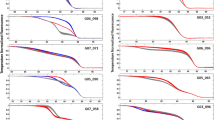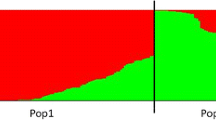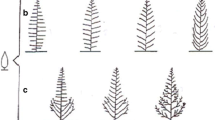Abstract
Two complex populations derived from the salt-tolerant citrus rootstock Cleopatra mandarin were used to investigate (1) the genomic regions affected by segregation distortion and (2) gene segregation heterogeneity and their causes and to obtain (3) a Citrus reshni linkage map to genetically analyze (4) the duration of the juvenility period and the seed embryony type. Both populations differed in the extent and origin of segregation distortion. The population derived from the cross between C. reshni and Poncirus trifoliata (R × Pr) showed 75 % of codominant markers with distorted segregation. The origin of this distortion was prezygotic in most cases. Meanwhile, 100 % of codominant markers in the self-pollinated population [F2(R × Pr)] showed genotypic distortion, and the origin of such distortion was mostly postzygotic, with the heterozygote being the most frequent genotype in all cases. In the R × Pr population, where two pollinator varieties were used, allele segregation was significantly heterogeneous not only in P. trifoliata (28.6 % of markers) but also in C. reshni (19.5 %). The results on segregation heterogeneity in the F2(R × Pr) suggest the presence at linkage group 4c of a postfertilization system of balanced lethal factors that reduces homozygosis in self-compatible hybrids. Four low to medium contributing quantitative trait loci (QTLs) were detected for the duration of juvenility period by both Kruskal–Wallis and interval mapping methodologies. For seed embryony type, three QTLs were detected by both methodologies, with the previously reported Apo2 being the QTL contributing the most. CR14,290 and TAA15 are good markers for early selection of polyembryonic rootstocks in progenies derived from C. reshni, Citrus aurantium, and Citrus volkameriana.




Similar content being viewed by others
References
Ahmad R, Struss D, Southwick SM (2003) Development and characterization of microsatellite markers in Citrus. J Amer Soc Hort Sci 128:584–590
Aleza P, Juarez J, Ollitrault P, Navarro L (2010) Polyembryony in non-apomictic citrus genotypes. Ann Bot 106(4):533–454
Arumuganathan K, Earle ED (1991) Nuclear DNA content of some important plant species. Plant Mol Biol Rep 9:208–218
Asins MJ, García MR, Ruiz C, Carbonell EA (2002) Molecular markers for the genetic analysis of apomixis. In: Jain SM, Brar DS, Ahloowalia BS (eds) Molecular techniques in crop improvement. Kluwer Academic Publishers, The Netherlands, pp 265–281
Asins MJ, Bernet GP, Ruiz C, Cambra M, Guerri J, Carbonell EA (2004) QTL analysis of Citrus tristeza virus-citradia interaction. Theor Appl Genet 108:603–611
Bacchi O (1943) Cytological observations in Citrus. III. Megasporogenesis, fertilization and polyembryony. Bot Gaz 105:221–225
Barkley NA, Roose ML, Krueger RR, Federici CT (2006) Assessing genetic diversity and population structure in a citrus germplasm collection utilizing simple sequence repeat markers (SSRs). Theor Appl Genet 112:1519–1531
Bernet GP, Asins MJ (2003) Identification and genomic distribution of gypsy-like retrotransposons in Citrus and Poncirus. Theor Appl Genet 108:121–130
Bernet GP, Fernandez-Ribacoba J, Raga V, Asins MJ (2008) Comparison of linkage maps among six citrus species: structural differences and genetic inferences. In: Deng X, Xu J, Lin S, Guan R (eds) Proceeding 11th international citrus congress, vol I. China Agriculture Press, Beijing, p 463
Bernet GP, Fernandez-Ribacoba J, Carbonell EA, Asins MJ (2010) Comparative genome-wide segregation analysis and map construction using a reciprocal cross design to facilitate citrus germplasm utilization. Mol Breed 25:659–673
Bretó MP, Ruiz C, Pina JA, Asins MJ (2001) The diversification of Citrus clementina Hort. ex Tan., a vegetatively propagated crop species. Mol Phylogenet Evol 21(2):285–293
Cameron JW (1979) Sexual and nucellar embryony in F1 hybrids and advanced crosses of Citrus with Poncirus. J Amer Soc Hort Sci 104:408–410
Cameron JW, Frost HB (1968) Genetics, breeding and nucellar embryony. In: Reuther W, Batchelor LD, Webber HJ (eds) The citrus industry, vol II, Div Agr Sci. Univ California, Berkeley, pp 325–370
Cameron JW, Garber MJ (1968) Identical-twin hybrids of Citrus × Poncirus from strictly sexual seed parents. Amer J Bot 55:199–205
Chen C, Bowman KD, Choi YA, Dang PM, Rao MN, Huang S, Soneji JR, McCollum TG, Gmitter FG Jr (2008) EST-SSR genetic maps for Citrus sinensis and Poncirus trifoliata. Tree Genet Genomes 4:1–10
Cooper WC (1961) Toxicity and accumulation of salts in Citrus trees on various rootstocks. P FL St Hortic Soc 74:95–104
Edmé SJ, Glynn NG, Comstock JC (2006) Genetic segregation of microsatellite markers in Saccharum officinarum and S. spontaneum. Heredity 97:366–375
Fang DQ, Roose ML, Krueger RR, Federici CT (1997) Fingerprinting trifoliate orange germ plasm accessions with isozymes, RFLPs, and inter-simple sequence repeat markers. Theor Appl Genet 95:211–219
Frost HB (1943) Seed reproduction: development of gametes and embryos. Chapter VIII. In: Webber HJ, Batchelor LD (eds) The citrus industry, vol I. University of California Press, Berkeley, pp 767–815
García R, Asins MJ, Forner J, Carbonell EA (1999) Genetic analysis of apomixis in Citrus and Poncirus by molecular markers. Theor Appl Genet 99:511–518
García MR, Bernet GP, Puchades J, Gómez I, Carbonell EA, Asins MJ (2002) Reliable and easy screening technique for salt tolerance of citrus rootstocks under controlled environments. Aust J Agric Res 53:653–662
Guerra M (1984) Cytogenetics of Rutaceae. II. Nuclear DNA content. Caryologia 37:219–226
Jansen RC (2001) Quantitative trait loci in inbred lines. In: Balding DJ, Bishop M, Gannings G (eds) Handbook of statistical genetics. Wiley, New York, pp 567–597
Kepiro JL, Roose ML (2010) AFLP markers closely linked to a major gene essential for nucellar embryony (apomixis) in Citrus maxima × Poncirus trifoliata. Tree Genet Genomics 6:1–11
Kijas JMH, Thomas MR, Fowler JCS, Roose ML (1997) Integration of trinucleotide microsatellites into a linkage map of Citrus. Theor Appl Genet 94:701–706
Melchinger AE, Utz HF, Schön CC (2004) QTL analyses of complex traits with cross validation, bootstrapping and other biometric methods. Euphytica 137:1–11
Nakano M, Shimizu T, Kuniga T, Nesumi H, Omura M (2008) Mapping and haplotyping of the flanking region of the polyembryony locus in Citrus unshiu Marcov. J Japan Soc Hort Sci 77(2):109–114
Ruiz C, Asins MJ (2003) Comparison between Poncirus and Citrus genetic linkage maps. Theor Appl Genet 106:826–836
Ruiz C, Bretó MP, Asins MJ (2000) An efficient methodology to identify sexual seedlings in citrus breeding programs using SSR markers. Euphytica 112:89–94
Van Ooijen JW, Maliepaard C (1996) MapQTL(tm) version 3: software for the calculation of QTL positions on genetic maps. CPRO-DLO, Wageningen
Van Ooijen JW, Voorrips RE (2001) JoinMap version 3.0. software for the calculation of genetic linkage maps release 3.0. Plant Research International, Wageningen, The Netherlands
Acknowledgments
This work has been partially supported by grants FP6-2003-INCO-MPC-2, RTA2006-0009-00-00, AGL2008-00197/AGR, Fondo Social Europeo (GPB), and IVIA (VR). We thank J. Puchades and P. Cirujeda for the technical assistance.
Author information
Authors and Affiliations
Corresponding author
Additional information
Communicated by A. Dandekar
Rights and permissions
About this article
Cite this article
Raga, V., Bernet, G.P., Carbonell, E.A. et al. Segregation and linkage analyses in two complex populations derived from the citrus rootstock Cleopatra mandarin. Inheritance of seed reproductive traits. Tree Genetics & Genomes 8, 1061–1071 (2012). https://doi.org/10.1007/s11295-012-0486-7
Received:
Revised:
Accepted:
Published:
Issue Date:
DOI: https://doi.org/10.1007/s11295-012-0486-7




